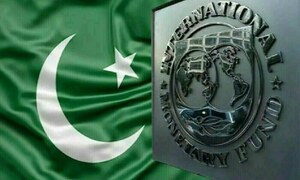IMF Adjusts Pakistan’s Growth Forecast Downward
The International Monetary Fund (IMF) has tempered its growth expectations for Pakistan, revising the GDP growth rate downward by 0.4% to 2.6% for the fiscal year 2025. This adjustment contrasts with the earlier projection of 3% made in January 2025.
In its recent publication, the “World Economic Outlook (WEO) a critical juncture amid policy shifts,” the IMF anticipates a GDP growth of 2.6% for Pakistan in 2025, followed by a rise to 3.6% in 2026.
Previously, the IMF’s January 2025 WEO had estimated Pakistan’s GDP growth at 3% for fiscal year 2025 and 4% for 2026.
Pakistan’s GDP experienced growth of 0.92% during July-September and 2.5% in FY24.
The IMF has also adjusted its inflation rate forecast, projecting it at 5.1% for the current fiscal year and 7.7% for fiscal year 2026, a significant decrease from the 23.4% recorded in fiscal year 2024.
Unemployment in Pakistan is expected to decline to 8% in 2025, compared to 8.3% in 2024, with a further projected decrease to 7.5% in 2026.
The current account balance is projected to be negative 0.1% for 2025, an improvement from the negative 0.5% in 2024, but is expected to remain negative at 0.4% for 2026.
The IMF forecasts general government net lending/borrowing at negative 5.6% of GDP for 2025, compared to negative 6.8% of GDP for 2024.
The Asian Development Bank (ADB) has similarly adjusted its GDP growth forecast for Pakistan for fiscal year 2025, lowering it to 2.5% from the 3% projected in December 2024. The ADB emphasized that Pakistan’s economic prospects heavily rely on the successful implementation of ongoing economic reforms. The bank clarified that these projections preceded the US administration’s April 2 announcement of new tariffs.
The World Bank postponed the release of its Pakistan Development Outlook, initially scheduled for April 9, to re-evaluate projections following the tariff announcement.
According to the IMF report, the global economy has shown signs of stabilization following a series of unprecedented shocks, albeit with modest growth rates. However, evolving policy priorities and heightened uncertainties have reshaped the economic landscape.
Global growth forecasts have been significantly revised downwards compared to the January 2025 WEO Update, reflecting unprecedented effective tariff rates and a volatile environment. The decline in global headline inflation is projected to be slightly slower than previously anticipated in January.
The report further emphasized that the outlook is dominated by escalating downside risks, fueled by increasing trade tensions and financial market adjustments. Shifting policy positions and declining confidence could tighten global financial conditions.
An escalating trade war and heightened trade policy uncertainty may further impede both short-term and long-term growth prospects. Reduced international cooperation could jeopardize efforts to build a more resilient global economy.



Comments (0)
No comments yet. Be the first to comment!
Leave a Comment